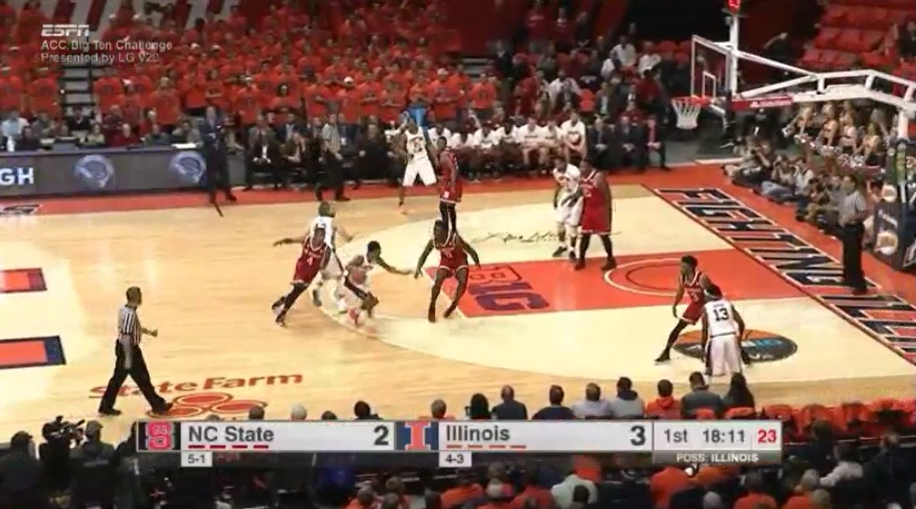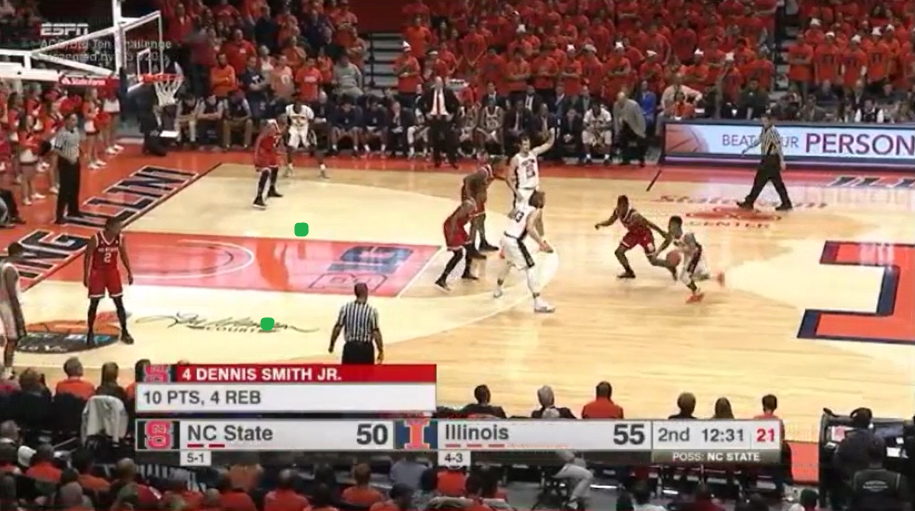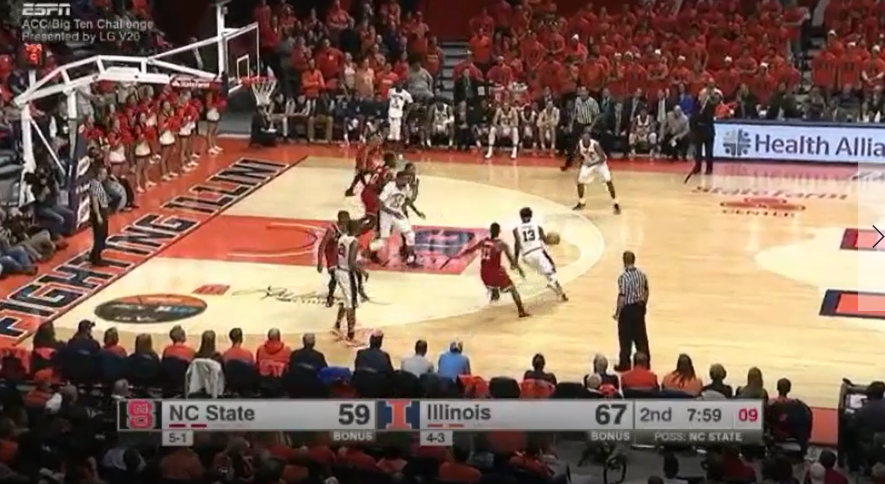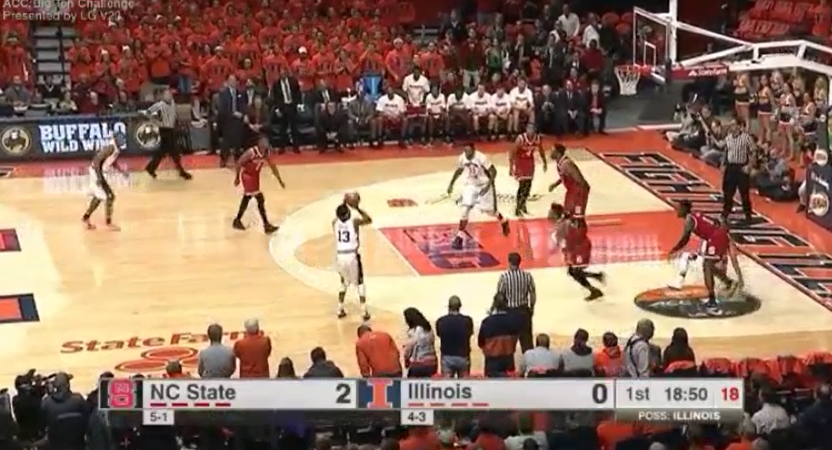This is the second in a series of posts breaking down the defensive deficiencies of State’s men’s basketball team. If you missed part one, check it out here, then come back and dive into our next category of defensive failings:
Off-Ball Awareness
This next category is a sort of catch-all for our problems with off-ball complacency, lack of awareness, and help defense. It’s a bit of a grab bag, but it does all kind of tie together.
First, we’re going to start with something that’s driven me crazy about our defense for a long time, what I entitled in my notes as a “lazy switch”. What I mean by this is that often when opposing guards run dribble handoffs or even very simple cross cuts, our guards will switch their man even when there’s no real reason to do so. It happens a lot during each game, but I’ve picked out a couple examples:
Now, the first three examples seem pretty harmless, particularly the first. There’s no real reason to switch, but there’s no reason not to, right? Like I said before, State makes these switches all the time. Now look, having guards that can switch on defense is good, and if you get screened and have to switch, then fine. These switches aren’t that though, they’re switches that don’t need to happen. There are a few problems with this. One, it says that you don’t care which guards are matched up against which. In rare instances that might be true, but most of the time you should want your best defensive guard matched up with their best offensive guard. You want guys who match up well physically. It’s a marked disadvantage for Markell Johnson to be matched up against a big, physical wing like Malcolm Hill. If you have to switch, fine, but make the opponent work to get the mismatch. Two, it goes to what I talked about in the last post, it promotes passive defense instead of active defense. Third, sometimes you get what happens in the last clip, when you miscommunicate the unnecessary switch and give up a wide open layup.
Second, lets talk about off-ball help and awareness. I’ll tackle the first thing in pictures, not in video (you’ll see it in the later clips). Our wings tend to drop far too deep on defense for my liking. When opposing players are in the corners, our guys are often standing right in line between them and the basket. For example, look at Terry Henderson here:
 He’s covering his man, but he’s not doing any good to the rest of the team. He should be at least one big step higher on the court. If he’s there, he can still easily get to his man if the pass comes that way (and he’d even be in better position to intercept the pass), but he’s also going to deter penetration simply by being there. From his current position, he’s way too far away if that player decides to turn the corner and drive on Abu, he’s no help. I mean, look at where our wings are on this play:
He’s covering his man, but he’s not doing any good to the rest of the team. He should be at least one big step higher on the court. If he’s there, he can still easily get to his man if the pass comes that way (and he’d even be in better position to intercept the pass), but he’s also going to deter penetration simply by being there. From his current position, he’s way too far away if that player decides to turn the corner and drive on Abu, he’s no help. I mean, look at where our wings are on this play:
The guy doesn’t end up driving to the hoop, but look at the ocean of space we’re leaving open. Nobody is within 15 feet of the rim. If he gets a good screen, there’s zero resistance. Those two defenders should be a lot closer to where I’ve put the green dots. Now, this play didn’t end up hurting us, but it could have, and we certainly have been hurt by it quite a bit. Defense requires a full team effort, and when you’re glued to your man like that, you’re hurting the whole team. You have to stick close to great shooters, sure, but even if Dorn was guarding Steph Curry, there’s no reason he can’t take one step towards the top of the key here. He still contests the pass, he can still easily get back to his man in time, and he’s actually in better position if the guy goes backdoor.
Now, lets get into some more concrete examples of poor help:
There are a few different things going on here, but lets go one by one. On the first play, we see something that has plagued us over the last few years, confusion over help responsibilities. The play starts with a pick-and-roll, and we’ll come back to the problems there at the point of attack in my next post, but for now the important thing is what happens after the pass. Dorn gets caught in no-man’s land here. Even if he’s supposed to cover for that pass (which I suspect he isn’t), he’s too late in getting there. What’s more, he and Abu both end up lunging to guard the same player. Whenever that happens, it’s a sure sign someone screwed up. If Dorn is supposed to cover that man, somebody else should be rotating to cover his man. If he’s not supposed to, he’s just unnecessarily left his man wide open. This is not an isolated occurrence either, it’s a thing that we generally do multiple times a game, where two guys will go to cover the same spot. It’s a failure of communication and a failure of preparation. Look, basketball is a hard game, and you have to make a lot of split-second decisions. I’m sure Dorn saw the ball going to an open man and just went to it, that’s understandable. But this is why you practice these things over and over, so that you start to make the correct reads by instinct, and so that you trust the defensive system to cover where it’s supposed to cover.
The next 3 plays are all displays of varying degrees of laziness or inattentiveness that lead to open drives down the lane. The first one is actually pretty good help defense on the back side. Smith does a great job of reading the play, and he’s able to save a layup by stripping the ball. The problem here is Dorn, who stays glued to his man the whole time. Like I noted before, he’s too close to the baseline, and if he steps up in help defense there, he frees Kapita to stay closer to his man. If he were guarding a shooter, that’s one thing, cause he’s one pass away he should probably stay at home, but he’s guarding Leron Black, who has taken 9 three pointers in his career and made none of them. You have to know personnel, who you can sag off of and who you have to shadow. Take advantage of his weakness to clog up driving lanes. The second and third plays are simple, nobody steps up to stop the ball. Dorn gets a pass on this one because he’s guarding Malcolm Hill, who he should not help off of in this instance. The one who should be helping in both these plays is Abu. He’s in position to help both times, and both times he gives up open layups. The first he don’t even attempt to contest, choosing instead to box out for a rebound that’s never coming. The entire time #2 is driving down the lane, Abu does not take a single step towards him. The second happens not at the rim but at the elbow, and it’s inexplicable. Instead of taking a step into the lane and sealing it off, Abu actually slides away from the ball-handler who is driving past him. Seriously, it looks like he’s allergic to defense on that play. Again, he’s not guarding a shooter. We do not care if #12 gets the ball 20 feet from the rim. We care about keeping the guy with the ball out of the paint. It’s incredibly frustrating to watch.
The last play of the video is another example of being too focused on your man at the expense of the team, and it also features Abu. Watch what happens as #13 gets the ball on the dribble handoff. He starts curling towards the lane as Abu is recovering back to his man on the perimeter. They are about to pass like ships in the night. Look at this:
If Abu simply lifts his head up, sees the man driving, and stops where he is, he will be in perfect help position. He will wall off that drive. #13 can then pass to the wide open non-shooter Leron Black, and nothing bad will happen. Instead, Abu continues on his way, and he’s got a foot on the three point line as #13 is taking his layup.
The overarching theme of these problems is just a lack of awareness. We have players who are so focused on their man that they’re out of position to help, and when they are in position, they don’t help anyway. Now, even great defenses have breakdowns, but I’m not pulling these examples out because they’re unique, I’m highlighting them because they happen far too often in our games. These kinds of breakdowns in help are systemic. These same problems also overflow into our next section…
Boxing Out
I’m not going to spend nearly as much time on boxing out because there’s really only so much you can say, and the video is pretty self-explanatory. One thing that you’ll see pretty consistently is players simply turning towards the rim when the shot goes up instead of finding their man and putting a body on him.
I’m not going to go through each one, as its pretty apparent what’s going on. It’s a lot of our guys just not recognizing Illinois players running to the rim, so no one puts a body on them. It’s a particularly rough lowlight reel for Torin Dorn, but I’m not going to bag on him as much based on one game of footage. His rebound numbers are excellent for his position, so it may just be a case of him having one poor game. That aside, it’s an issue that shows up with the rest of our players as well, and it’s an extension of the complacency and lack of awareness that we’ve been talking about in other areas. You cannot be glued to your man the whole possession, then totally disregard him as soon as the shot goes up.
We should focus on that first play a little more, because boy is it a disaster. At the time the shot goes up, one Illinois player is completely out of frame because he’s already jogged down court. Another player is sitting on the ground.
Look at that picture. We do not get that rebound. How? Also, if that ball had bounced off the other side of the rim, we still wouldn’t have gotten it because #43 had inside position on Abu. So what happens? Abu is unable to get around the guy sitting on the floor. Beejay doesn’t so much box out as he does deliver a forearm to the throat. Dennis Smith does not box out his man but lets him run untouched to get the ball. Dorn doesn’t help either of his bigs box out, he just stands under the rim waiting for the ball to fall in his lap. This is about as badly as a team can box out.
So what can we say about this? There are times when poor rebounding is a symptom of something else, maybe you’re giving up too many drives to the rim and the help rotations are necessarily leaving the glass open. There are times when you can be in good position and the ball just happens to bounce wrong, or you have it and it just bounces off your hands and you can’t secure it (that happened twice this game). These things all do happen to us, but far too often we see plays like that first one, where by all accounts we should get the rebound, and through carelessness we give it up. That’s less a matter of talking about technique (though we could certainly talk to Beejay about his stiffarm boxout move), and more about effort and mentality. Take pride in your rebounding as much as you do your dunking. That sounds like I’m an old curmudgeon, but it’s true. Especially when you’re trotting out 4 guard lineups like State is, you have to make an emphasis to put a body on someone. That’s on players, but it’s also on the coaching staff to drill that into them. If guys who space out on defense or don’t box out ride the bench, then you create a culture that this is important. Based on years of evidence, we do not have that culture here at State.
Lastly, I’ll leave you with a clip of one play that kind of encompasses everything we’ve talked about in this post. Note the time and score, how important the moment is. 7 points in 4:30 is hard, but certainly doable. This is a crucial possession if we wanted to stay in this game. Now, watch Abu, particularly from the 12 second mark onward.
For 8 seconds straight, he does not look at his man. He has no idea where he is. As a result of that, he does not call out either of the screens set (which is what frees up Smith’s man to take the shot), nor does he box out on the rebound. He then compounds the error by weakly fouling for the and-1. It is a crucial moment, and player in his third year plays the worst defensive possession of the game. He is pulled because it’s his fourth foul. Two minutes later he’s back in the game. When there are no consequences, there is no motivation to improve.
The last part of this series will take a closer look at a more technical subject, our pick-and-roll coverage.






You must be logged in to post a comment.